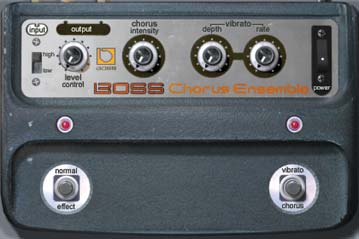Volume 3, Number 3, May 2005
[UA Universe] [Ask the Doctors] [Digital Minds] [Analog Obsession]
[Support Report] [The Channel] [Plug-In Power] [Analog Ears] [Featured Promotion]
[Graphic-Rich WebZine]
[Back Issues] [UA Home]
Plug-In Power
Boss CE-1 & Roland Dimension D
by Dave Crane
 |
|
UAD Boss CE-1
|
UAD Boss CE-1 Chorus
As you may recall from last month's article, the CE-1 is considered by many to be the holy grail of chorus stomp boxes, and soon it will be just as desirable in the world as a plug-in. In the video below, I'm playing a guitar loop through the CE-1, which is on the master bus. Placed here, the CE-1 is true stereo out, with the chorus in both left and right channels. This is different from the way the actual pedal works. In Stereo mode, the pedal has a processed signal in one channel, and a dry one on the other. If you want to do that with the plug-in, you can simply open it as a mono-to-stereo plug-in, but I really like the sound of true stereo chorus.
“That is what people love about the Dimension D; even though there are almost no parameters to adjust, It always sounds right.”
 |
|
UAD Roland Dimension D
|
UAD Roland Dimension D
As you can see (and hear!) the UAD-1 Roland plug-ins are very versatile, and not just for guitarists. They can be used as effects, as well as general audio enhancement tools.